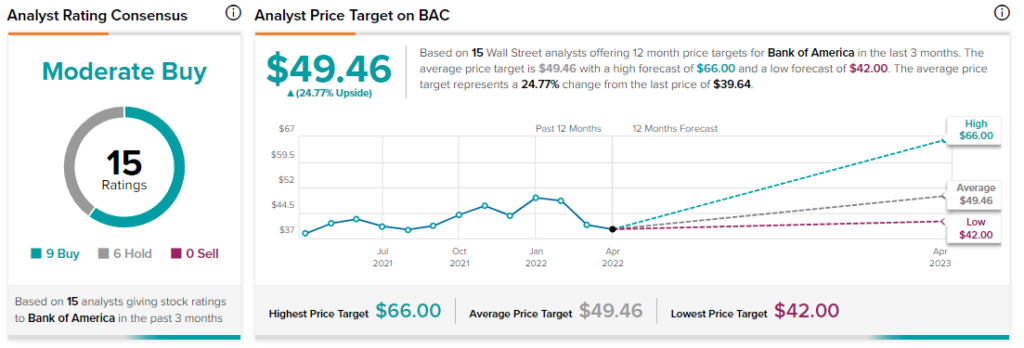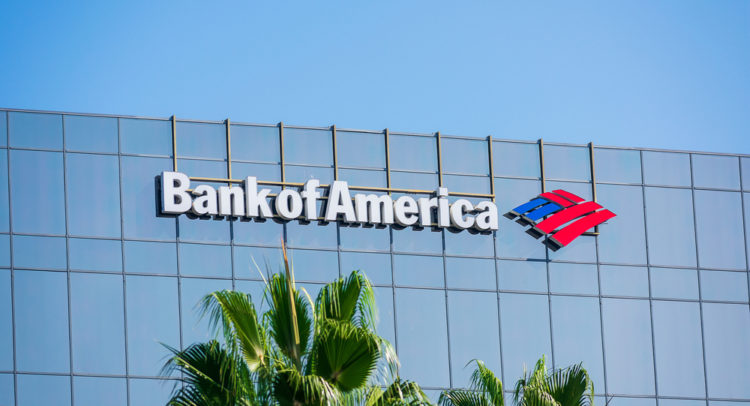Bank of America (BAC) is only just beginning to feel the tailwinds of higher interest rates. While rates will only rise gradually over the next few years, I think the most likely scenario is that over the long term we observe higher rates than the ones of the past decade.
Given the tangible positive expectations are already priced in the stock, I am neutral on BAC. The stock may come under pressure over the short term due to normalized level of credit provisions and the time needed for higher rates to show in the income statement.
Bank of America operates in four key divisions, namely Consumer Banking at 38% of Q1 2022 revenue, Global Banking at 22.3% of Q1 2022 revenue, Global Wealth & Investment Management at 23.6% of Q1 2022 revenue, and Global Markets at circa 22.8% of Q1 2022 revenue.
The first two divisions are more exposed to rising rates as compared to the latter two, which rely on strong capital markets activity.
Q1 Operational Overview
Bank of America delivered a 15.51% return on average common shareholders’ equity (ROTCE) primarily driven by strong operational performance and a negligible $30 million net provision for credit losses.
However, year-over-year the allowance for loan and lease losses is down 25% from $16.17 billion to $12.1 billion, thus I think the bulk of the pandemic-related provision releases are behind us.
Going forward I reckon the bank will gradually move to a range of provision for credit losses in the area of $0.9 billion to $1 billion per quarter, which should push the ROTCE down to 14%. As I will elaborate below, this will likely be more than compensated by rising rates in the years to come.
Another highlight from Q1 is that deposit growth, at 13%, outpaced loan growth at 8%, reinforcing the strong consumer headlines we have heard from the other banks to report earnings so far.
The capital position (CET1 at 10.4%) deteriorated both quarter-over-quarter and year-over-year, mainly driven by an increase of risk-weighted assets of 8.7% from the previous year.
Nevertheless, there is no reason to expect the 66% payout ratio will be affected as the capital cushion (0.9% over the 9.5% CET1 requirement) is sufficient, given the strong earnings profile of the bank.
How High Will Rates Rise?
It is safe to say that Bank of America, along with other financial institutions, is coming out of a period of structurally depressed earnings (due to low interest rates) into a more normal era of higher rates and overall a more pleasant environment for banks.
All in all, I think there are three main scenarios for rates. The first one is a gradual rise to about 2.5%-3%, with limited movements in either direction (the current market base case).
The second one envisions a steep rise above 3% should the FED decide to aggressively fight inflation, likely followed by a recession (the least possible scenario in my view).
Last, but not least, the third one entails a rise in rates to 2.5%-3% which manages to tackle inflation and is followed by another rate cutting cycle, very much akin to what we saw last time (the second-least likely scenario in my opinion).
As a refresher, the last Fed rate raising cycle started in December 2015 and ended in December 2018. Afterwards, the Fed was on pause for H1 of 2019 before resuming rate cuts in H2 2019.
Scenario 1
While you should take current market expectations with a grain of salt, the current market consensus is that the Fed gradually raises rates to about 3% in the next few years, and they stay in a 3%-3.3% range between 2025 and 2052.
Obviously, implied forward rates are a poor predictor of actual forward rates. Nevertheless, in a 3% Fed Funds scenario Bank of America will benefit on two fronts.
Firstly, as rates rise faster than BAC needs to raise rates on deposits, the net interest yield (which measures the basis points Bank of America earns over the cost of funds) will likely improve from the current 1.69%.
For comparison, the net interest yield stood at 2.43% in 2019. However, at the end of the day rates will stop rising and the net interest yield will settle at a new position once deposit rates have caught up with loan rates.
The more material benefit will come from the sustained higher returns Bank of America can earn on its tangible shareholders’ equity, which stood at around $172.1 billion at the end of Q1. I estimate higher rates should add about $4.3 billion to pre-tax income and the ROTCE should end up in the high teens.
Scenario 2
While unlikely, this may be the most beneficial scenario for Bank of America. Firstly, rates will rise higher and for longer than in the previous scenario, thus prolonging the time it takes for deposits to catch up with loan rates.
In the meantime, this will increase the net interest yield even more. Even if rates do rise somewhat higher than 3%, they will fail to stay there for more than a year. This will limit the long-term impact on Bank of America’s profitability. Nevertheless, the bank may experience a brief period of ROTCE in the low 20s.
Scenario 3
We have seen it before, once everyone is preoccupied with a particular theme the peak is in and a mad rush for the exit ensues.
Unlikely as it may seem at present, perhaps the gradual Fed hikes over the next few years manage to bring inflation in check, and it even returns to the low levels observed until recently, forcing the Fed into a new rate cutting cycle.
As in the scenario above, the boost to earnings would prove to be temporary, and Bank of America would earn a ROTCE in the mid teens for the foreseeable future.
Wall Street’s Take
From Wall Street analysts, Bank of America earns a Moderate Buy rating, based on nine Buy ratings, six Hold ratings and zero Sell ratings.
Additionally, the average Bank of America price target of $49.46 puts the upside potential at 24.8%.

Investor Takeaway
While a normalized level of credit provisions will mean earnings for Bank of America will get worse before they improve later on the back of higher rates, the most likely scenario outlined above envisions a 3% Fed funds world in which Bank of America sustainably earns a high teens ROTCE.
Thus, I think that accumulating a position on pullbacks will pay off in the longer term.
Discover new investment ideas with data you can trust.
Read full Disclaimer & Disclosure









